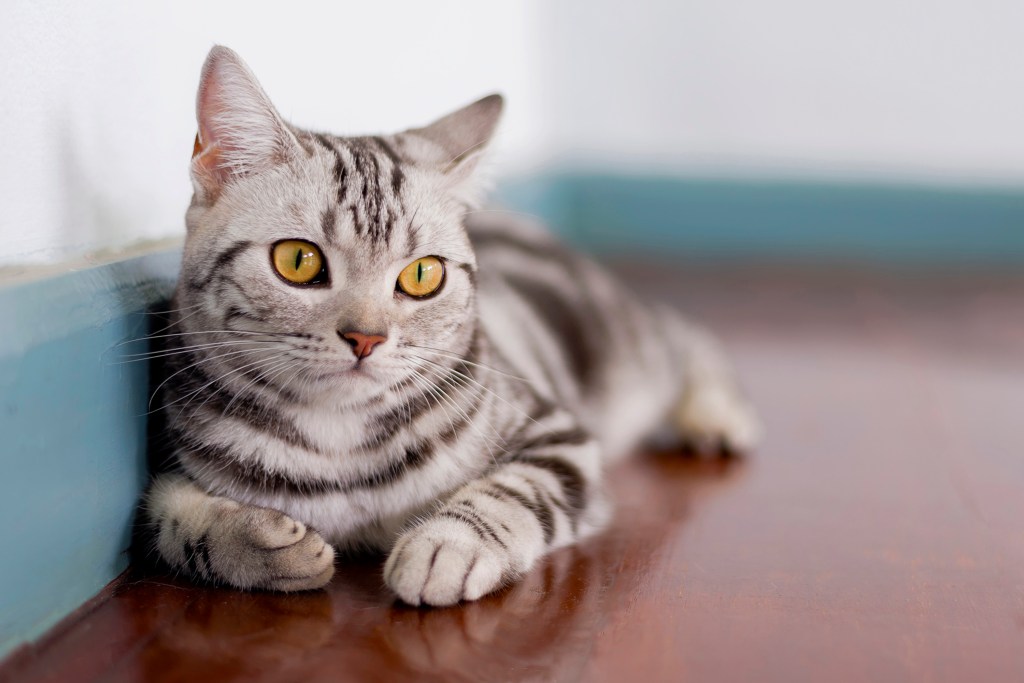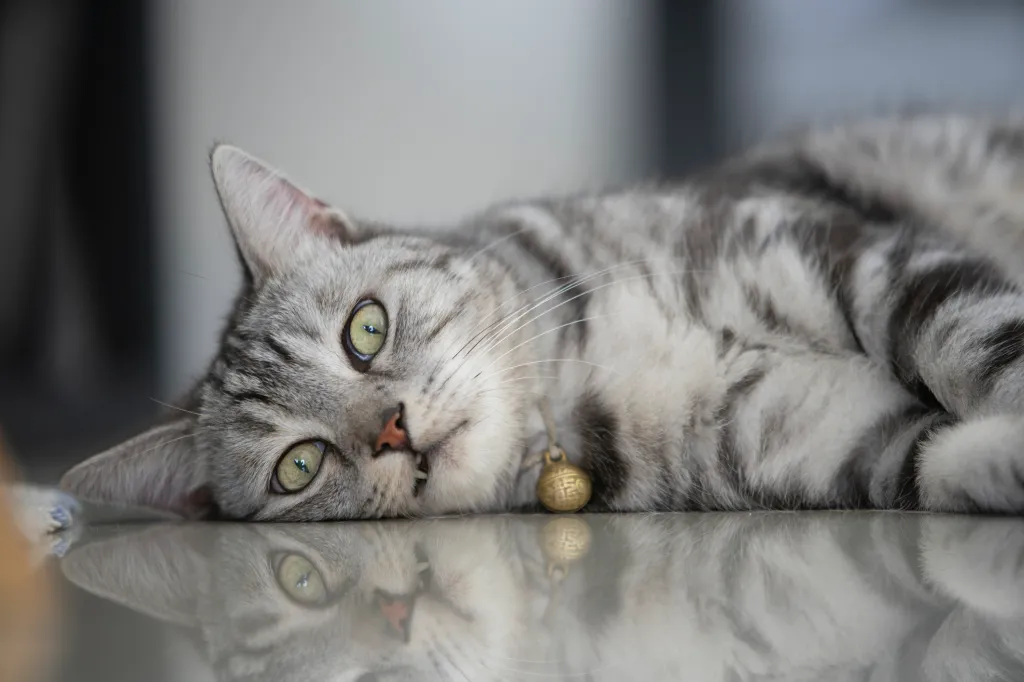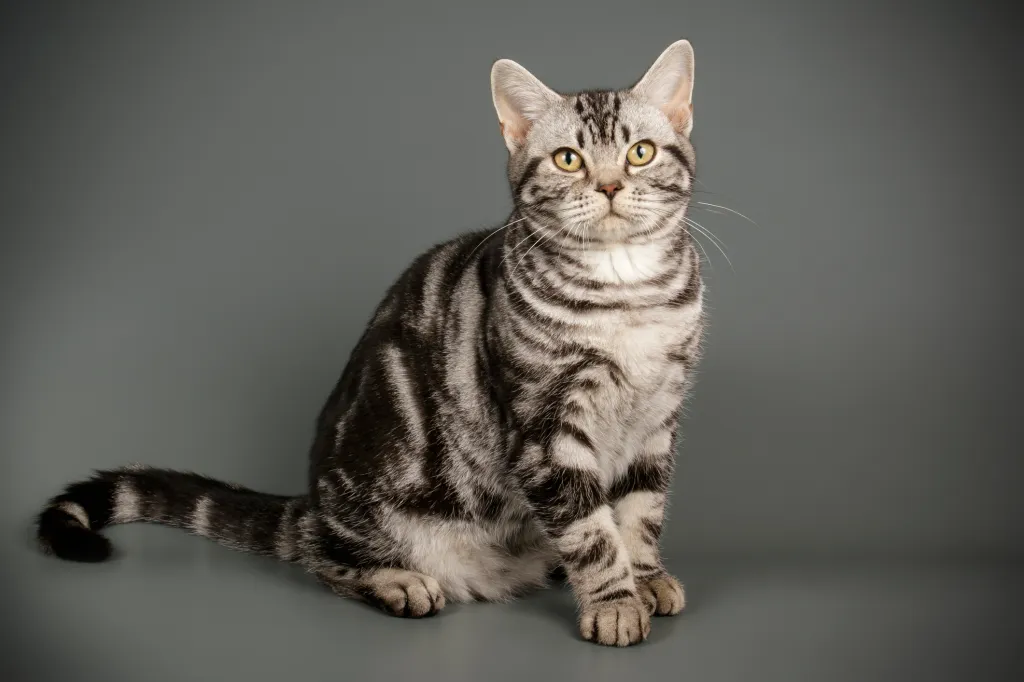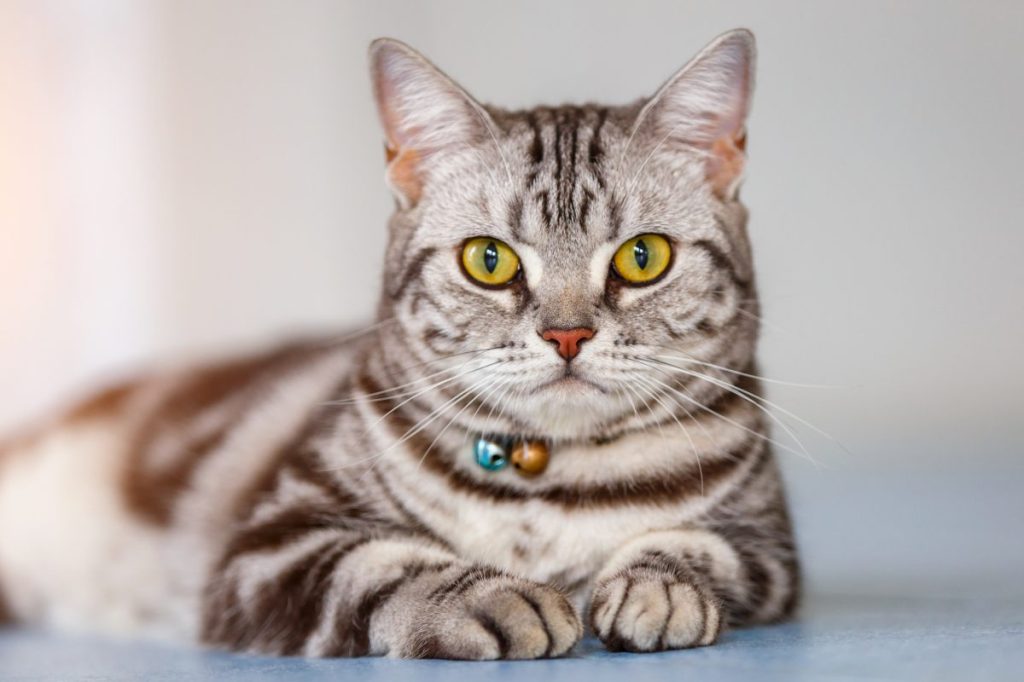The American Shorthair (ASH) cat is a versatile and widely popular breed recognized for their friendly demeanor, adaptable nature, and classic appearance. Originally descended from cats that sailed on ships with early European settlers, the breed evolved in the United States over the centuries. Known for their medium to large size, sturdy build, and short, dense coat, the American Shorthair is characterized by a round face, expressive eyes, and a well-balanced body.
One of the key features of the American Shorthair is their diverse coat colors and patterns, ranging from classic tabby patterns to solid colors, bi-colors, and more. The breed is low-maintenance in terms of grooming, as their short coat does not require extensive care. American Shorthairs are known for their amiable and gentle nature, making them excellent companions for families, singles, and seniors alike. They are generally adaptable to different living environments and tend to get along well with children and other pets.
When considering an American Shorthair kitten, it’s advisable to prioritize adopting from rescue organizations or shelters to provide a loving home to a cat in need. However, if you decide to purchase, it’s crucial to choose a reputable breeder. Conduct thorough research to ensure that the breeder follows ethical practices and prioritizes the well-being of their cats. Reputable American Shorthair kitten breeders prioritize the health and temperament of their cats, conduct necessary health screenings, and provide a nurturing environment for the kitties. This active approach ensures that you bring home a healthy and happy kitty while discouraging unethical breeding practices.
Quick Facts
- Origin: United States, descended from European working cats brought on ships, naturally developed breed with a history dating back centuries.
- Size: Medium (7-12 pounds)
- Breed Group: Shorthaired Domestic
- Lifespan: 15-20 years, known for their longevity.
- Coat: Short, dense, and weatherproof, comes in a vast array of colors and patterns including solid, tabby, bi-color, tortoiseshell, and pointed.
- Temperament: Easygoing, adaptable, friendly, playful when young, enjoys human interaction but also independent.
- Exercise Needs: Moderate – appreciates playtime and mental stimulation but content with quiet time too.
- Training: Trainable with positive reinforcement due to their intelligence, often playful learners.
- Grooming: Minimal, weekly brushing to remove loose hair.
- Health: Generally healthy, robust breed with few pre-existing conditions.
- American Shorthair cats do not mature until they are three or four years old.
- This breed came over on the Mayflower, making it America’s first cat, and witnessing the birth of the nation.
American Shorthair Pictures



-
Affectionate with Family
Some cat breeds are typically independent and aloof, even if they’ve been raised by the same person since kittenhood; others bond closely to one person and are indifferent to everyone else; and some shower the whole family with affection. Breed isn’t the only factor that goes into affection levels; cats who were raised inside a home with people around feel more comfortable with humans and bond more easily.

See Cats Less Affectionate with Family -
Amount of Shedding
If you’re going to share your home with a cat, you’ll need to deal with some level of cat hair on your clothes and in your house. However, shedding does vary among the breeds. If you’re a neatnik, you’ll need to either pick a low-shedding breed or relax your standards. This furniture cover can make it easier to clean up cat hair and keep it off your sofa!
-
General Health
Due to poor breeding practices, some breeds are prone to certain genetic health problems. This doesn’t mean that every cat of that breed will develop those diseases; it just means that they’re at an increased risk. If you’re looking only for purebred cats or kittens, it’s a good idea to find out which genetic illnesses are common to the breed you’re interested in.
-
Potential for Playfulness
Some cats are perpetual kittens—full of energy and mischief—while others are more serious and sedate. Although a playful kitten sounds endearing, consider how many games of chase the mouse-toy you want to play each day, and whether you have kids or other animals who can stand in as playmates. A classic wand cat toy like this one is perfect for playful felines!
-
Tendency to Vocalize
Some breeds sound off more often than others with meows, yowls, and chattering. When choosing a breed, think about how the cat vocalizes and how often. If constant “conversation” drives you crazy, consider a kitty less likely to chat.
-
Kid-Friendly
Being tolerant of children, sturdy enough to handle the heavy-handed pets and hugs they can dish out, and having a nonchalant attitude toward running, screaming youngsters are all traits that make a kid-friendly cat. Our ratings are generalizations, and they’re not a guarantee of how any breed or individual cat will behave; cats from any breed can be good with children based on their past experiences and personality.
-
Friendly Toward Strangers
Stranger-friendly cats will greet guests with a curious glance or a playful approach; others are shy or indifferent, perhaps even hiding under furniture or skedaddling to another room. However, no matter what the breed, a cat who was exposed to lots of different types, ages, sizes, and shapes of people as a kitten will respond better to strangers as an adult.
-
Easy to Groom
Some breeds require very little in the way of grooming; others require regular brushing to stay clean and healthy. Consider whether you have the time and patience for a cat who needs daily brushing. You should definitely pick up this awesome de-shedding tool for cats of any hair length!
-
Intelligence
Some cat breeds are reputed to be smarter than others. But all cats, if deprived the mental stimulation they need, will make their own busy work. Interactive cat toys are a good way to give a cat a brain workout and keep them out of mischief. This scratcher cat toy can keep your smart kitty busy even when you’re not home!
-
Pet Friendly
Friendliness toward other household animals and friendliness toward humans are two completely different things. Some cats are more likely than others to be accepting of other pets in the home.
American Shorthair History
They aren’t listed on the manifest, but cats were undoubtedly among the passengers and crew that disembarked from the Mayflower when it arrived at Plymouth, Massachusetts, in 1620. Their ratting abilities made cats valued members of ships’ crews, and they may well have made their way to the New World even earlier, on ships that carried settlers to the Jamestown colony in Virginia, Spanish explorers to Florida and Vikings to Newfoundland.
Some of the descendants of those seafaring cats, known prosaically as shorthairs, or domestic shorthairs, became what we know today as American Shorthairs. Cats were valued on land as well as at sea. Farmers, shopkeepers and householders all needed a good cat to protect their stores of food from mice, rats and other vermin.
The shorthairs were solid, hardy working stock, well suited to the tough conditions that prevailed on the untamed continent. Such good hunters were they that a publication from 1634 credits them with saving a New England colony’s crops from squirrels and chipmunks.
From their coastal arrival points, they went west with settlers, and thrived. By 1895, shorthairs had made enough of a mark that they were exhibited at the first cat show in the United States. The Cat Fanciers Association recognized them as a breed in 1906. To differentiate them from random-bred cats, also known as domestic shorthairs, the pedigreed felines were given the name American Shorthair in 1966. The cats are recognized by all registries.
American Shorthair Size
The American Shorthair weighs 7 to 12 pounds.
American Shorthair Personality
The adaptable and good-natured American Shorthair retains his hunting ability, but these days he is more likely to be a family companion, a job at which he excels. He has a middle-of-the-road temperament, being calm but not comatose. The American Shorthair is moderately active and enjoys a good playtime as much as the next cat, but he’s not overly demanding of attention or activity.
As befits a working class cat who has made good, he is smart and enjoys playing with puzzle toys and interactive toys. He has a sociable nature and isn’t the type to hide under the bed when visitors arrive. This is a placid cat but one that doesn’t especially like being carried around. Let him stand on his own four feet. He may or may not be a lap cat, but he will always appreciate having a spot next to you on the sofa or at the end of the bed.
American Shorthair Health
Both pedigreed cats and mixed-breed cats have varying incidences of health problems that may be genetic in nature. American Shorthairs are generally healthy, but be sure to ask a breeder about the incidence of health problems in her lines and what testing has been done for any that are genetic in nature.
- Hypertrophic Cardiomyopathy: Hypertrophic Cardiomyopathy (HCM) is a common heart condition in cats, characterized by the thickening of the heart muscle. It is particularly prevalent in certain breeds, such as Maine Coon, Ragdoll, and Persian cats.
- Polycystic Kidney Disease: Polycystic Kidney Disease (PKD) is a hereditary condition that affects the kidneys of cats. It is characterized by the formation of fluid-filled cysts within the kidney tissue, gradually leading to an enlargement of the kidneys and a decline in their function.
American Shorthair Care
The American Shorthair’s coat is easily cared for by combing or brushing it a couple of times a week to remove dead hair and distribute skin oils. The thickness of the cat’s coat and the amount it sheds vary based on climate and time of year.
Brush the teeth to prevent periodontal disease. Daily dental hygiene is best, but weekly brushing is better than nothing. Trim the nails every couple of weeks. Wipe the corners of the eyes with a soft, damp cloth to remove any discharge. Use a separate area of the cloth for each eye so you don’t run the risk of spreading any infection.
Check the ears weekly. If they look dirty, wipe them out with a cotton ball or soft damp cloth moistened with a 50-50 mixture of cider vinegar and warm water. Avoid using cotton swabs, which can damage the interior of the ear.
American Shorthairs like their meals, so they can easily become overweight. To prevent obesity, measure their food instead of free-feeding them. Keep the litter box spotlessly clean. Cats are very particular about bathroom hygiene, and a dirty box may cause them to start using other places in the house instead.
It’s a good idea to keep an American Shorthair as an indoor-only cat to protect him from diseases spread by other cats, attacks by dogs or coyotes, and the other dangers that face cats who go outdoors, such as being hit by a car. Keeping him indoors also protects local birds and wildlife from this talented hunter. American Shorthairs who go outdoors also run the risk of being stolen by someone who would like to have such a beautiful cat without paying for it.
American Shorthair Coat Color And Grooming
The American Shorthair has the body of a working cat: stocky, muscular and strong. His build gives him the agility and endurance he needs as a first-rate stalker, and heavily muscled legs make him capable of pouncing, jumping and climbing to get his furred or feathered prey. This is a medium-size to large cat, slightly longer than he is tall. A large head with a full-cheeked face gives the American Shorthair a sweet, open expression.
He has medium-size ears that are slightly rounded at the tips and large, wide eyes. A short, thick coat comes in a large assortment of colors and patterns: solid, tabby, calico, tortoiseshell, bicolor, particolor and more. The silver classic tabby pattern is probably the most popular of them all.
Children And Other Pets
The laidback but playful American Shorthair is a perfect choice for families with children and cat-friendly dogs. He can learn tricks and loves the attention he receives from children who treat him politely and with respect. He will get along fine with dogs if they don’t give him any trouble.
He is a skilled hunter, but may learn to leave pet birds or other small animals alone if he is introduced to them at an early age. When in doubt, however, separation is best. Always introduce any pets, even other cats, slowly and in a controlled setting.
American Shorthair Rescue Groups
More Info For You
If you’re also looking for a dog, check out DogTime’s dog breed page!





